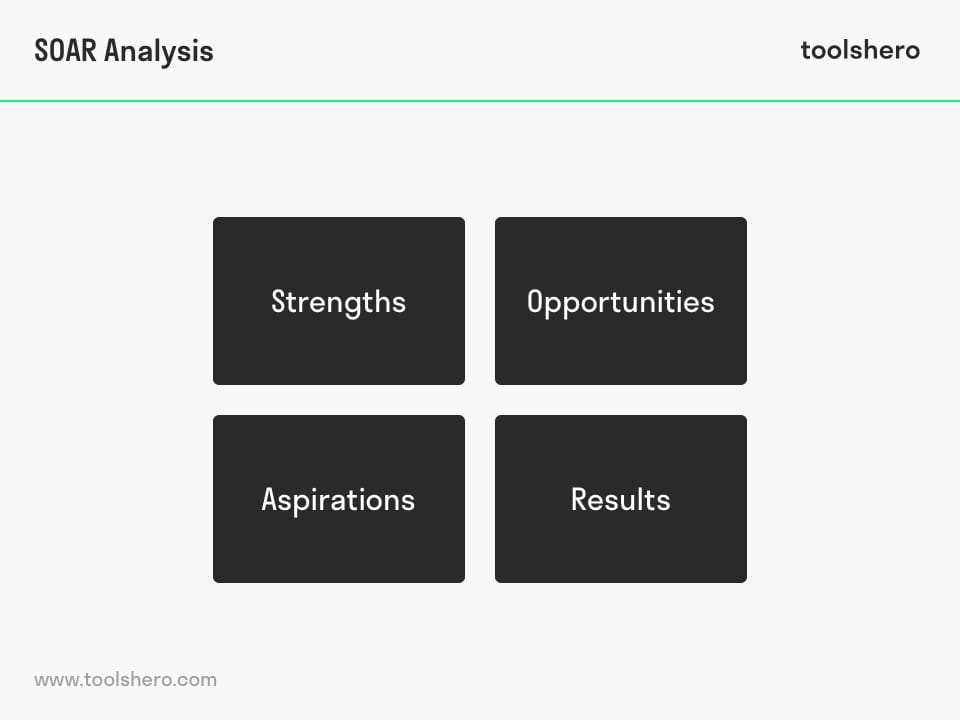SOAR Analysis: the theory plus example and template

SOAR Analysis: this article explains the SOAR Analysis in a practical way. Other highlights include: a comparison of the SOAR and SWOT Analysis, a closer look at SOAR and the execution of this analysis. Lastly, this article also contains a downloadable and editable SOAR Analysis template. After reading it, you will understand the basics of this strategic planning tool. Enjoy reading!
What is the SOAR Analysis?
A SOAR Analysis helps organisations to focus on their current strengths and future vision for the benefit of developing strategic goals. This makes it a strategic planning method that helps organisations focus on their future ambitions. This makes it into a strategic planning method that helps organisations focus on their future ambitions and the result these ambitions will yield. This strategic model is an acronym of Strengths, Opportunities, Aspirations and Results.
Soar meaning
This strategic model is an acronym of Strengths, Opportunities, Aspirations and Results.
Both existing and new organisations can make good use of a this type of analysis. It works for everyone within an organisation, irrespective of position or hierarchical level. It can also be aimed at both the internal target groups (employees) and external target groups (stakeholders). A SOAR Analysis is also useful for organisations that strive for breakthroughs, wish to improve their skills or focus on other development plans.
SOAR Analysis vs SWOT Analysis
A SOAR analysis closely resembles a SWOT Analysis, where an internal analysis of the organisations strengths and weaknesses first takes place. SWOT and SOAR are two populair strategy tools. Subsequently, the SWOT Analysis looks at external challenges and opportunities of and threats to the organisation.
A SOAR Analysis, however, is more action oriented than a SWOT and is aimed at results. SOAR focuses all levels and functional areas of an organisation, while SWOT usually adopts a top-down approach.
This analysis focuses on the organisation itself and on improving what is already going well. A SWOT Analysis, on the other hand, looks at perceived threats and / or weaknesses of the organisation.
Contrary to the SWOT Analysis, this model uses appreciative research to direct the company towards what is already known.
As such, the output of a SOAR contains a series of actions that capitalise on the strengths and opportunities. In doing so, the organisation can strive for ambitions shared by the entire organisation; in measurable results.
This analysis offers a basis for further thorough analysis by means of other company assets. The questions below can be useful in conducting this analysis:
- What are the organisations strengths?
- Which opportunities exist for the organisation?
- What does the perfect future of the organisation look like?
- Which measurable results show that the organisations future vision has been reached?
SOAR Analysis in closer detail
Further building on an organisations strengths will yield better results than spending time on improving weaknesses. Every element of the SOAR Analysis is described in further detail below, with several example questions:
Strengths
Within the SOAR Analysis, this concerns the most powerful strengths of an organisation. It refers to all capacities, skills and achievements (whether big or small). The following example questions apply:
- At what does the organisation excel?
- What have been the greatest achievements so far?
- What makes the organisation valuable to purchasers?
- What does the organisation do better than its competitors?
Opportunities
These are aimed at possibilities and chances the organisation has. It concerns external conditions that could improve the profit or that focus on unfulfilled needs of customers.
Opportunities is the section of the SOAR that can also lead to a larger market share or improve the competitive advantage. Possible organisational threats or weaknesses can be formulated into opportunities. All opportunities that emerge will eventually lead to success. Here too, example questions can be useful:
- Which collaborations could increase the chance of success?
- Which changes and market trends match with the current strengths of the organisation?
- Which threats could the organisation embrace and convert into opportunities?
- Which gaps could the organisation fill in the market?
Aspirations
Within the SOAR Analysis, these concern the ambitions an organisation has. What does the organisation aspire to be and what can it realise? Which aspirations does the organisation have for the future, what is their vision?
Within this vision, an organisation would do well to build on its current strengths. With sufficient inspiration, the aspirations could be clarified and the following example questions can be helpful:
- What does the organisation hope to achieve in the future?
- What will the future of the organisation look like?
- What is the passion of the organisation?
- Which strategies and actions could support the future ambitions?
Results
This refers to the tangible and measurable results that indicate when the goals and aspirations have been achieved. The following example questions can be useful for this:
- Which measures ensure that the organisation is on the right track for success?
- How does the organisation translate the vision of success into tangible results?
- When does the organisation know the goals have been achieved?
The SOAR Analysis and support
A SOAR Analysis is a powerful tool for uniting stakeholders. This is crucial to recognise the organisations potential and create a shared vision of the future. Building on an organisations strengths requires fewer effort and resources than attempting to correct weaknesses.
Moreover, this analysis creates support within an organisation as it involves representatives in each level of the organisation. Opening communication leads to input on strategy and strategic planning.
In doing so, resistance against change is minimised. Employees will more easily commit to the goals and objectives they helped to create (bottom up).
Additionally, the SOAR Analysis is flexible and scalable. Planning and decision making are adapted to the needs and culture of an organisation.
The SOAR model can be used to explore new initiatives, develop a strategic plan and during annual strategic assessments. It can also be used as part of a leadership development programme and in the career development of individual employees.
Execution of the SOAR Analysis
In order to achieve the best possible results, an organisation should conduct the analysis with a diverse group. For instance, employees from various levels who each have a different perspective of the situation. In addition to employees from different departments, other stakeholders, such as customers, suppliers, and partners, could also be involved.
In general, an effective SOAR Analysis takes up to one hour, including attention to brainstorming and prioritize actions. Developing an initial action plan also often takes one hour.
After it is known who will participate in the SOAR Analysis, the phase of data collection follows. Participants look for the Strengths, Opportunities, Aspirations, and Results step by step. Powerful, positive questions help to generate the opportunities.
A questionnaire that guides the meeting could also be useful. Possible threats, weaknesses, or problems must not be ignored. By reframing these, opportunities arise.
By jointly determining which opportunities show the most potential, the organisation’s aspirations can be considered. Eventually, this will lead to an action plan, time plan and division of tasks.
SOAR Analysis template
Reach new defined strategic goals by describing the different aspects of the SOAR Analysis with this ready to use SOAR Analysis template.
Download the SOAR Analysis template
This template is exclusively for our paying Toolshero members. Click here to see if a membership is something for you!Now it’s your turn
What do you think? Do you recognize the explanation of the SOAR analysis? Does this model help your organization to focus on its current strengths and vision for the future? Do you have any tips or comments?
Share your experience and knowledge in the comments box below.
More information
- Silbert, J. H., & Silbert, T. (2007). SOARing from SWOT: Four lessons every strategic plan must know. AI Practitioner: International Journal of AI Best Practic, 1-4.
- Stavros, J. M., & Cole, M. L. (2014). SOARing towards positive transformation and change. ABAC ODI JOURNAL VISION. ACTION. OUTCOME., 1(2).
- Stavros, J. M., & Hinrichs, G. (2011). The thin book of® SOAR: Building strengths-based strategy. Thin Book Publishing.
How to cite this article:
Mulder, P. (2019). SOAR Analysis. Retrieved [insert date] from Toolshero: https://www.toolshero.com/strategy/soar-analysis/
Original publication date: 03/14/2019 | Last update: 03/08/2024
Add a link to this page on your website:
<a href=”https://www.toolshero.com/strategy/soar-analysis/”>Toolshero: SOAR Analysis</a>













